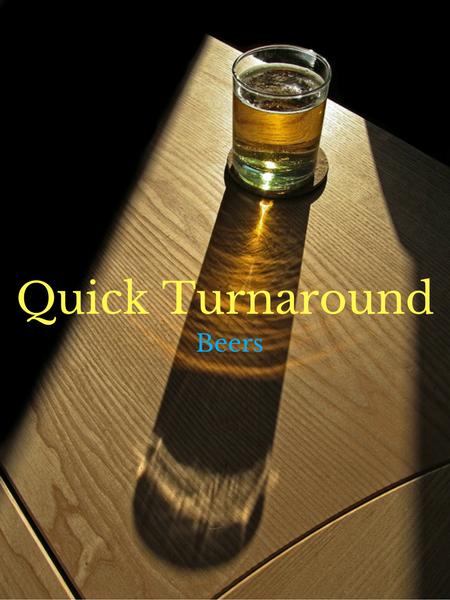Brewing Beers With A Quick Turnaround
Table of Contents
Is It Possible To Go From Grain To Glass In 10 Days?
Brewing a quick turnaround beer or a “fast” beer is entirely possible and something I have done before in a pinch. Today we will look at some of the factors to take note of brewing a beer quickly.
You have just gone to get a bottle of home brew from the fridge, there are only a couple left. You check the keg you started a few weeks back and there is only a few pints left. Pretty soon you’ll be all out of beer. If you brew fairly regularly then you may have had the experience of getting caught out in a position like this. What you need is a home brew that has a quick turnaround. From grain to glass in as short of a period as possible. You want to get the fridge stocked and a keg filled.
Of course taking your time with each batch of beer is likely to yield the best results in the long term. There are ways, however, of making good beer that don’t require lot’s of time to be ready. It is a case of thinking about the way beer conditions and ages and then building your recipe around this.
How To Brew Quick Turnaround Beers
The length of time it takes for a beer to be ready is variable. A lot of factors can make affect the time from grain to glass. Trying to compress this period to get a beer ready to drink requires a little bit of thought.
There are definitely beer styles that you won’t be able to brew quickly and you can take off the list. High gravity beers and sour beers require a lot of time fermenting and conditioning to be contenders for a quick turnaround beer. The same applies to lagers which take much longer to ferment at low temperatures than ales fermented at warmer temperatures (although commercial brewers even turn lager out quickly).
Now we have excluded a few beer styles it gives us a bit more direction on what we should be looking to brew. A beer that has a low starting gravity will ferment quicker than a high gravity beer and a quick fermenting ale yeast to shorten the time it takes to get to final gravity.
The Importance of Yeast For Brewing Beers Quickly
When brewing any beer the biggest chunk of time from the brewday to getting the beer kegged or bottled is the fermentation and conditioning period. If you can shorten this phase of making the beer then the turnaround will be much quicker.
This fermentation and conditioning phase is all down to the yeast and the environment they have in the wort you produce. Producing a wort that has ideal conditions and pitching the right amount of healthy, viable yeast cells will mean they can ferment the wort and produce less undesirable flavours during the process. Reusing yeast from a previous batch is an ideal way to pitch enough yeast.
Choosing A “Fast” Yeast Strain
Selecting a yeast strain to ferment a beer quickly means you need to look for certain traits. The best strains will likely have the following characteristics:
High attenuation – High attenuation means the yeast will ferment out to a low final gravity and usually in a timely fashion
Highly flocculant – High flocculation will result in the yeast dropping out of suspension quickly so once fermentation is complete the beer clears a lot quicker. Although wheat beer strains are an exception
Tolerates higher fermentation temperatures – If you can ferment a beer warmer, around 22°C for example, the yeast will attenuate out much faster than at 18°C. Optimal ranges for yeast are always listed on the package, at these higher end of these optimal ranges the yeast will ferment quicker without producing undesirable compounds such as higher alcohols and phenols.
Picking yeast strains with these traits will usually result in faster fermenting beers and beers that condition a lot quicker than usual.
Utilising Bold & Strong Flavours
“Fast” brewed beers can suffer from being “green”. In other words, most beers take a little time for the flavours and byproducts created during fermentation to even out and round off. This is why we want to choose a yeast strain that limits the production of byproducts that will affect the taste of the beer.
Conditioning the beer for a period of a few weeks to allow the flavour to round out really isn’t an option if you want to brew a beer quickly and be drinking it in around 10 days. If however we make a lower alcohol, bold flavoured beer any potential undesirable flavours can be overwhelmed so you don’t notice their presence. Clean tasting or subtle beers are usually best avoided for quick to brew beers.
Choosing roasted grains and caramel malts with bags of flavour will fill the palate when you drink it, the same is true of using bold, fruity and citrusy hops. When you fill a beer with flavour any undesirable flavours that are a consequence of short brewing times get disguided.
A Couple of Examples
- Make a 4% ABV Stout and the dominant flavour you are going to taste straight from the fermenter is toasty, roasty, chocolate and toffee notes. Big bold flavours will always shine.
- A Session Pale Ale of around 3.8% with bags of hops added at the end of the boil. The main flavour will be these aroma hops even before the beer has been carbonated the flavours fill the mouth
- A 3.2% Mild although being a really low ABV has complex malt driven flavour. Mild are a definite contender for being one of the best fast to brew beers.
- A 4.5% wheat beer although it uses simple fairly neutral tasting ingredients has one of the boldest tasting yeast strains. Wheat beers are also hazy by nature so flocculation of the yeast isn’t really a concern.
Packaging & Carbonating Your Beer
A truly quick beer will need to be kegged and force carbonated, a process that will take far less time than bottling and waiting for the beer to carbonate over a week or two. Once the beer is racked into a keg you can add CO2 immediately by either shaking the keg or if you have one using a carbonation stone. This will easily carbonate the beer within 24 hours and you can start pouring straight away.
If you have no other option than to bottle the beer, you will have to wait at least a week to achieve any kind of carbonation. The process can be sped along a little by holding the bottles at around 26°C for 3 – 4 days. This is how many commercial breweries bottle condition beers by using warm rooms. After a few days, you can let the bottles condition at normal temperature and check the carbonation by opening a bottle. Once carbonated the bottles can be chilled and served as and when needed.





Leave a Reply
Want to join the discussion?Feel free to contribute!